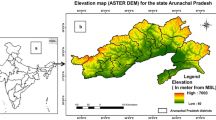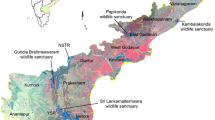Abstract
The western Himalayan forests have frequent forest fire that affect its forest wealth, biodiversity, ecology and environment. Ironically, there is a scarcity of a comprehensive and systematic effort to know its fire-sensitive forest regions. Therefore, the present study was carried out in Kangra region of Indian western Himalaya to identify suitable conditions for forest fire by overlaying geographical coordinates of recorded fire locations on various thematic layers such as elevation, slope, aspect, mean annual temperature and fuel map of the region. Based on suitability table, the regions with favourable fire conditions were extracted from above thematic layers in GIS environment. The fire-sensitive regions were further prioritized into very high, high, medium, low, and very low forest fire-prone areas. The Pinus roxburghii forest type, low elevation, high temperature, high slope, south-west facing aspect, May month and anthropogenic disturbances were identified as major factors responsible for forest fire in the region. The half of the forest cover was identified as fire sensitive. The 10.7 % of the forest cover in the study area was categorized as ‘very high’ and ‘high’ forest fire-prone areas. The 14.02 % villages of the region were identified as ‘high’ forest fire prone. The P. roxburghii, mixed forest species, khair forest (Acacia spp.) and oak forest (Quercus spp.) were identified as fire-sensitive forest types of the region.







Similar content being viewed by others
References
Arino O, Stefano C, Danil S (2012) Global night-time fire season timing and fire count trends using the ATSR instrument series. Remote Sens Environ 116:226–238
Bahuguna VK (1999) Forest fire prevention and control strategies in India. Int For Fire News 20:5–9
Bahuguna VK, Lal P (1989) The effects of fire on the nature and properties of forest soil: a review of the work done. My Forest 25(4):381–391
Bahuguna VK, Singh S (2002) Fire situation in India. Int For Fire News 26:23–27
Banskota K, Karky BS, Skutsch M (2007) Reducing carbon emissions through community managed forests in the Himalaya. International Centre for Integrated Mountain Development Kathmandu, Nepal, pp 9–20
Brown PM, Bhattacharyya A, Shah SK (2011) Potential for developing fire histories in chir pine (Pinus roxburghii) forests in the Himalayan Foothills. Tree-Ring Res 67(1):57–62
Burrough PA, McDonell RA (2005) Principles of geographical information systems. Oxford University Press, Oxford, pp 164–166
Chavan ME, Das KK, Suryawanshi RS (2012) Forest fire risk zonation using remote sensing and GIS in Huynial watershed, Tehri Garhwal district, UA. Int J Basic Appl Res 2:6–12
DDMP (2011) Kullu district disaster management plan. District Disaster Management Authority (DDMP), Kullu
DDMP (2012a) Hamirpur district disaster management plan. District Disaster Management Authority (DDMA), Hamirpur
DDMP (2012b) Kinnaur district disaster management plan. District Disaster Management Authority (DDMA), Kinnaur
FSI (2011) India state forest report 2011. Forest Survey of India, Dehradun
Gupta B, Mehta R, Mishra VK (2009) Fire ecology of ground vegetation in Pinus roxburghii sargent plantations in north-west himalaya—floristic composition and species diversity. Casp J Environ Sci 7(2):71–78
HPDR (2008) Himachal Pradesh Development Report, Planning Commission, Government of India
HPSPDM (2011) Himachal Pradesh State Policy on Disaster Management, Department of Revenue, Government of Himachal Pradesh
HPSRP (2007) A report on Himachal Pradesh State Road Project, Himachal Pradesh Road and other Infrastructure Development Corporation (HPRIDC). Public Works Department, Himachal Pradesh
http://www.wildlifeconservationtrust.org/newsdetail.php?id=1526
http://hpforest.nic.in/pages/show/NXNkNGZhhHo2NXNkNA==-fire-management
Huang SS (2004) 9 ENVISAT multi-sensor data for fire monitoring and impact assessment. Int J Remote Sens 25:4411–4416
Joshi NR, Tewari A, Chand DB (2013) Impact of forest fire and aspect on phytosociology, tree biomass and carbon stock in Oak and Pine mixed Forests of Kumaun central Himalaya, India. Researcher 5(3):1–8
Kanga S, Sharma LK, Nathawat MS, Sharma SK (2011) Geospatial approach for forest fire risk modelling: a case study of Taradevi range of Shimla forest division in Himachal Pradesh, India. Indian For 137(3):296–303
Kaufman RR, Hao YJ, Salmon WM, Gao JM (2004) A technique for detecting burn scars using MODIS data. IEEE Trans Geosci Remote Sens 42:1300–1308
Kumar A, Uniyal SK, Brijlal (2007) Stratification of forest density and its validation by NDVI analysis in a part of western Himalaya, India using Remote sensing and GIS techniques. Int J Remote Sens 28(11):2485–2495
Kumar A, Singh KN, Brijlal, Chawla A, Uniyal SK, Kaushal R, Singh RD, Ahuja PS (2014) Regeneration pattern of tree species in forested landscapes of Himachal Pradesh, Western Himalayan Region, India. Proc Natl Acad Sci India Sect B Biol Sci 84(3):695–707
Lillisand T, Kiefer W (2000) Remote sensing and image interpretation, 4th edn. Wiley, New York
Malik T, Rabbani G, Farooq M (2013) Forest fire risk zonation using remote sensing and GIS technology in Kansrao Forest Range of Rajaji National Park, Uttarakhand, India. Int J Adv Remote Sens GIS 2(1):86–95
McFeeters SK (1996) The use of Normalized Difference Water Index (NDWI) in the delineation of open water features. Int J Remote Sens 17(7):1425–1432
MoEF (1999) National forestry action plan. Ministry of Environment and Forests (MoEF), Government of India, New Delhi
Myers N, Russell AM, Cristina GM, Gustavo AB, Kent J (2000) Biodiversity hotspots for conservation priorities. Nature 403:853–858
Pant S, Samant SS (2007) Assessment of plant diversity and prioritization of communities for conservation in mornaula reserve forest. Appl Ecol Environ Res 5(2):123–138
Reddy CS, Krishna PH, Anitha K, Joseph S (2012) Mapping and inventory of forest fires in Andhra Pradesh, India: current status and conservation needs. ISRN For 380412:1–10. doi:10.5402/2012/380412
Sangye M (2005) The impact of fire frequency on the regeneration of Pinus roxburghii in Eastern Bhutan. Post graduate dissertation report, University of Natural Resources and Applied Life Sciences, (BOKU), Vienna
Sharma S, Rikhari HC (1997) Forest fire in the central Himalaya: climate and recovery of Trees. Int J Biometeor 40:63–70
Sharma JK, Sharma S (2007) Litterfall under different aged Chir pine stands in Shiwalik hills of Himachal Pradesh in north-western Himalayas. Indian For 133(8):1081–1090
Sharma LK, Kanga S, Nathawat MS, Sinha S, Pandey PC (2012) Fuzzy AHP for forest fire risk modelling. Disaster Prev Manag 21(2):160–171
Singh KN, Brijlal (2006) Notes on traditional uses of Khair (Acacia catechu Willd.) by inhabitants of Shivalik Range in western Himalaya. Ethnobot Leafl 10:109–112
Singh JS, Rawat YS, Chaturvedi OP (1984) Replacement of oak forest with pine in the Himalaya affects the nitrogen cycle. Nature 311(5981):54–56
Sowmya SV, Somashekar RK (2010) Application of remote sensing and geographical information system in mapping forest fire risk zone at Bhadra wildlife sanctuary, India. J Environ Biol 31(6):969–974. Upper Saddle River, NJ 1997 (TOI, 2012, Times of India, June 28, 2012)
Acknowledgments
The authors acknowledge the financial and infrastructure support provided by Council of Scientific and Industrial Research (CSIR), Government of India under BSC-109 project. The Forest Survey of India and Himachal state forest department are acknowledged for forest fire-related information. The CGIAR-CSI, USGS, USA and Worldclim are acknowledged for DEM, LANDSAT and climatic data, respectively. Authors are also thankful to Dr. P. S. Ahuja, director, CSIR-IHBT and staff members of Biodiversity division of CSIR-IHBT for their support. This is CSIR-IHBT Communication No. 3615.
Author information
Authors and Affiliations
Corresponding author
Rights and permissions
About this article
Cite this article
Kumar, S., Meenakshi, Das Bairagi, G. et al. Identifying triggers for forest fire and assessing fire susceptibility of forests in Indian western Himalaya using geospatial techniques. Nat Hazards 78, 203–217 (2015). https://doi.org/10.1007/s11069-015-1710-1
Received:
Accepted:
Published:
Issue Date:
DOI: https://doi.org/10.1007/s11069-015-1710-1




